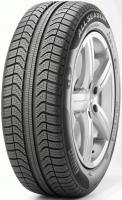Everyone knows tire performance changes with wear, with the biggest change in tire performance coming from all season and winter tires in snowy and icy conditions.
The drop in performance can be so vast after 4mm that certain countries where "three peak mountain and snowflake" tires are a legal requirement for winter driving, they can lose their legality after 4mm, meaning you only get to use half of your tires tread.
Should this be the case? Michelin have been making alot of noise recently regarding the negative impact of having to scrap a tire with half its tread life remaining, and their arguments are compelling. Not only are you costing the customer more, but you're also causing a much higher negative environmental impact by doubling natural resourse usage and doubling waste.

Europe's leading tire testers at the German publication Auto Bild have decided to find out exactly who's right. On test are six of the best all season tires, a set of summer tires and a set of winter tires. Each set of tires was tested at new, 4mm remaining tread depth, and 2mm remaining tread depth.
First, the negative. To reduce the tires tread depth Auto Bild milled the tires down to just above the target tread depth, then ran the tires on the road for 1,000km to re-bed them in. This isn't the ideal way of wearing the tires, in the real world the longer duration of use and more extreme environment has an effect of the chemical composition of the rubber, but it's realistically the only way of doing it for this type of test, as wearing hundreds of tires on the road is a very long and expensive process.
As for the results? It's certainly worth heading over to Auto Bild for the full picture as there's way too much data for us to summarise efficiently, so instead we'll concentrate on the popular Michelin CrossClimate, Goodyear Vector 4Season Gen-2, winter and summer tires in the test.
Snow
During snow braking, the Goodyear all season tire started the best, stopping the car in 27.6 meters, with the winter tire and Michelin CrossClimate close behind. At 4mm the order was the same, but the gaps between the tires closer, and by 2mm the Goodyear end as the worst of the three tires, with the Michelin just beating the full winter tire to being the best in the snow.
Snow handling saw a similar trend, but this time with the winter starting just ahead of the Goodyear. By 4mm the Michelin had taken the lead, which it further improved on at 2mm, proving to be the most consistent tire on test. The summer tire performed badly in both snow braking, and failed the snow handling test at 4 and 2mm tread depth.
Wet
The wet and the dry tests bring the summer tire back into contention. Wet braking sees the order of tire consistent, whatever the tread depth, with the Michelin proving best at all three levels of wear. The summer started ahead of the Goodyear all season, but the performance dropped off more at 2mm wear which means it finished tied, and the winter started the worst on test, and showed the largest drop in performance by 2mm.
Wet handling again showed the Michelin to be consistently the best tire, and again the winter had the largest drop in performance as the milimeters decreased.
Dry
Dry braking proved to be an interesting test. While the winter tire started extremely far behind the summer tire and Michelin CrossClimate, at 4mm it was performing the best, and by 2mm it had once again dropped behind the Michelin, but remained ahead of the summer tire.
The trend was broadly similar during dry handling, only with the winter tire finishing the best. Sadly we do not know what winter tire was used, or what temperature the wet and dry tests were conducted at, but it does highlight that once the "dry sipe disadvantage" of a winter tire has worn away, the softer, more elastic compound of the winer tire does have some benefits.
Conclusion
As this was primarily an all season tire test, the testers at Auto Bild only considered the all season tires in the final result, which are noted below. We recommend visiting the Auto Bild website to see the full data from all six all season tires on test.
1st: Michelin CrossClimate+ | |

| Exemplary all-rounder with balanced performance and the least performance degradation throughout the treadlife. One of the highest priced tires, but the mileage balances with the price as the best wearing tire on test. Highly recommended. Read Reviews Buy from £80.35 |
2nd: Goodyear Vector 4 Seasons Gen 2 | |

| Strong all-rounder with best performance on wet and snowy roads at new and 4 mm. Average dry grip to start with, but improves as the tire wears. Low rolling resistance, and a good price to wear ratio. Recommended. Read Reviews Buy from £77.77 |
3rd: Pirelli Cinturato AllSeason | |

| Only good in the snow when new, after 4mm the performance drops. Too expensive for the mileage provided, and high rolling resistance. Conditionally recommended. Read Reviews Buy from £85.52 |
4th: Hankook Kinergy 4S | |

| Like the Pirelli, the Hankook is only safe when new, with the snow and wet performance dropping with tire wear. The dry performance increases as the tread wears. Poor wear. Conditionally recommended. Read Reviews |
5th: Vredestein Quatrac 5 | |

| Balanced performance when new, but by 4mm the performance has dropped significantly. Conditionally recommended. Read Reviews Buy from £87.40 |
6th: Nokian WeatherProof | |

| One of the strongest performances when new, but weakest when worn. Poor mileage. Conditionally recommended. Read Reviews |




